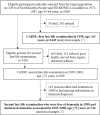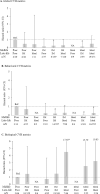Cardiovascular health metrics from mid- to late-life and risk of dementia: A population-based cohort study in Finland
- PMID: 33320852
- PMCID: PMC7737898
- DOI: 10.1371/journal.pmed.1003474
Cardiovascular health metrics from mid- to late-life and risk of dementia: A population-based cohort study in Finland
Abstract
Background: Very few studies have explored the patterns of cardiovascular health (CVH) metrics in midlife and late life in relation to risk of dementia. We examined the associations of composite CVH metrics from midlife to late life with risk of incident dementia.
Methods and findings: This cohort study included 1,449 participants from the Finnish Cardiovascular Risk Factors, Aging, and Dementia (CAIDE) study, who were followed from midlife (baseline from1972 to 1987; mean age 50.4 years; 62.1% female) to late life (1998), and then 744 dementia-free survivors were followed further into late life (2005 to 2008). We defined and scored global CVH metrics based on 6 of the 7 components (i.e., smoking, physical activity, and body mass index [BMI] as behavioral CVH metrics; fasting plasma glucose, total cholesterol, and blood pressure as biological CVH metrics) following the modified American Heart Association (AHA)'s recommendations. Then, the composite global, behavioral, and biological CVH metrics were categorized into poor, intermediate, and ideal levels. Dementia was diagnosed following the Diagnostic and Statistical Manual of Mental Disorders, Fourth Edition (DSM-IV) criteria. Data were analyzed with Cox proportional hazards and the Fine and Gray competing risk regression models. During the follow-up examinations, dementia was diagnosed in 61 persons in 1998 and additional 47 persons in 2005 to 2008. The fully adjusted hazard ratio (HR) of dementia was 0.71 (95% confidence interval [CI]: 0.43, 1.16; p = 0.174) and 0.52 (0.29, 0.93; p = 0.027) for midlife intermediate and ideal levels (versus poor level) of global CVH metrics, respectively; the corresponding figures for late-life global CVH metrics were 0.60 (0.22, 1.69; p = 0.338) and 0.91 (0.34, 2.41; p = 0.850). Compared with poor global CVH metrics in both midlife and late life, the fully adjusted HR of dementia was 0.25 (95% CI: 0.08, 0.86; p = 0.028) for people with intermediate global CVH metrics in both midlife and late life and 0.14 (0.02, 0.76; p = 0.024) for those with midlife ideal and late-life intermediate global CVH metrics. Having an intermediate or ideal level of behavioral CVH in both midlife and late life (versus poor level in both midlife and late life) was significantly associated with a lower dementia risk (HR range: 0.03 to 0.26; p < 0.05), whereas people with midlife intermediate and late-life ideal biological CVH metrics had a significantly increased risk of dementia (p = 0.031). Major limitations of this study include the lack of data on diet and midlife plasma glucose, high rate of attrition, as well as the limited power for certain subgroup analyses.
Conclusions: In this study, we observed that having the ideal CVH metrics, and ideal behavioral CVH metrics in particular, from midlife onwards is associated with a reduced risk of dementia as compared with people having poor CVH metrics. Maintaining life-long health behaviors may be crucial to reduce late-life risk of dementia.
Conflict of interest statement
The authors have declared that no competing interests exist.
Figures


Similar articles
-
The association of ideal cardiovascular health and left ventricle hypertrophy in rural population of northeast China: A cross-sectional observational study.Medicine (Baltimore). 2017 Feb;96(6):e6050. doi: 10.1097/MD.0000000000006050. Medicine (Baltimore). 2017. PMID: 28178152 Free PMC article.
-
Prevalence of the cardiovascular health status in adults: A systematic review and meta-analysis.Nutr Metab Cardiovasc Dis. 2018 Dec;28(12):1197-1207. doi: 10.1016/j.numecd.2018.08.002. Epub 2018 Aug 20. Nutr Metab Cardiovasc Dis. 2018. PMID: 30360955
-
Role of ideal cardiovascular health metrics in reducing risk of incident arrhythmias.Eur J Prev Cardiol. 2024 Apr 18;31(6):658-666. doi: 10.1093/eurjpc/zwad357. Eur J Prev Cardiol. 2024. PMID: 37966902
-
Association of the Duration of Ideal Cardiovascular Health Through Adulthood With Cardiometabolic Outcomes and Mortality in the Framingham Offspring Study.JAMA Cardiol. 2020 May 1;5(5):549-556. doi: 10.1001/jamacardio.2020.0109. JAMA Cardiol. 2020. PMID: 32159731 Free PMC article.
-
Association between ideal cardiovascular health metrics and risk of cardiovascular events or mortality: A meta-analysis of prospective studies.Clin Cardiol. 2017 Dec;40(12):1339-1346. doi: 10.1002/clc.22836. Epub 2017 Dec 26. Clin Cardiol. 2017. PMID: 29278429 Free PMC article. Review.
Cited by
-
Cardiovascular risk burden, dementia risk and brain structural imaging markers: a study from UK Biobank.Gen Psychiatr. 2024 Jan 29;37(1):e101209. doi: 10.1136/gpsych-2023-101209. eCollection 2024. Gen Psychiatr. 2024. PMID: 38292861 Free PMC article.
-
Change in cardiovascular health and rate of cognitive decline in older adults: a 15-year population-based study.BMC Geriatr. 2024 Mar 18;24(1):263. doi: 10.1186/s12877-024-04856-y. BMC Geriatr. 2024. PMID: 38500037 Free PMC article.
-
Heart Disease and Stroke Statistics-2023 Update: A Report From the American Heart Association.Circulation. 2023 Feb 21;147(8):e93-e621. doi: 10.1161/CIR.0000000000001123. Epub 2023 Jan 25. Circulation. 2023. PMID: 36695182 Free PMC article. Review.
-
Life's Essential 8 and midlife trajectories in cognition and brain health: The CARDIA study.Alzheimers Dement. 2025 May;21(5):e14464. doi: 10.1002/alz.14464. Epub 2024 Dec 23. Alzheimers Dement. 2025. PMID: 39711366 Free PMC article.
-
General population perspectives of dementia risk reduction and the implications for intervention: A systematic review and thematic synthesis of qualitative evidence.PLoS One. 2021 Sep 17;16(9):e0257540. doi: 10.1371/journal.pone.0257540. eCollection 2021. PLoS One. 2021. PMID: 34534250 Free PMC article.
References
Publication types
MeSH terms
LinkOut - more resources
Full Text Sources
Medical

